Question Number 181432 by mr W last updated on 25/Nov/22
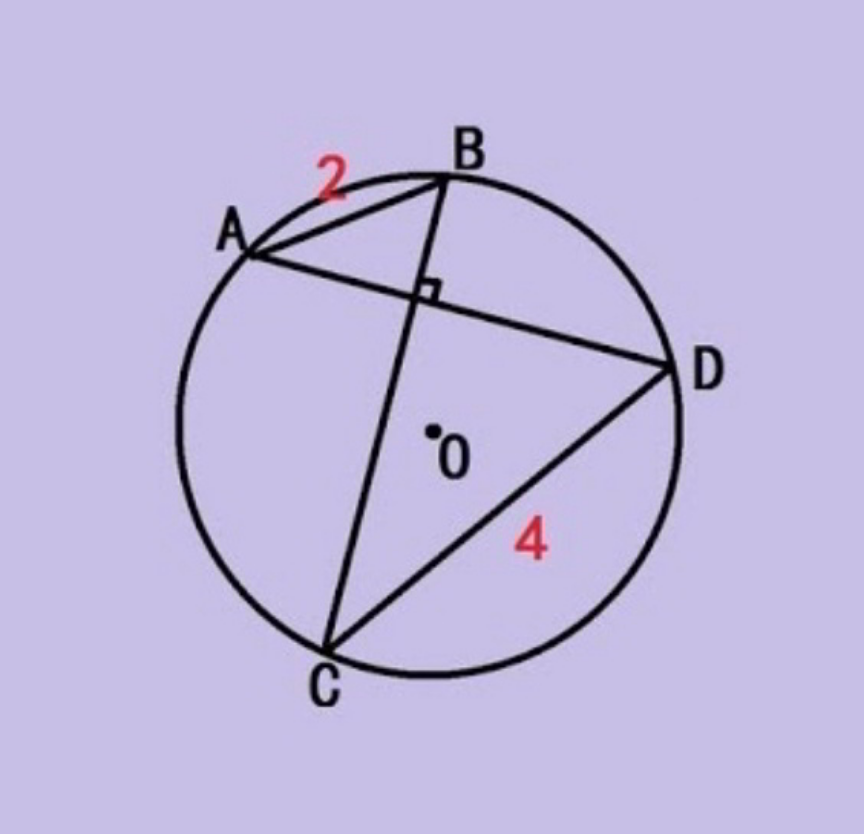
Commented by mr W last updated on 25/Nov/22

$${find}\:{the}\:{area}\:{of}\:{circle}. \\ $$
Commented by universe last updated on 25/Nov/22
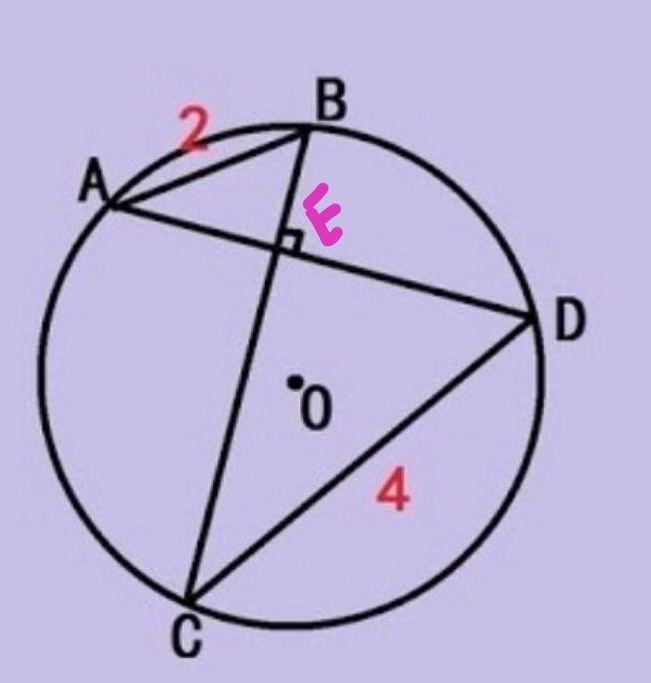
Commented by universe last updated on 25/Nov/22
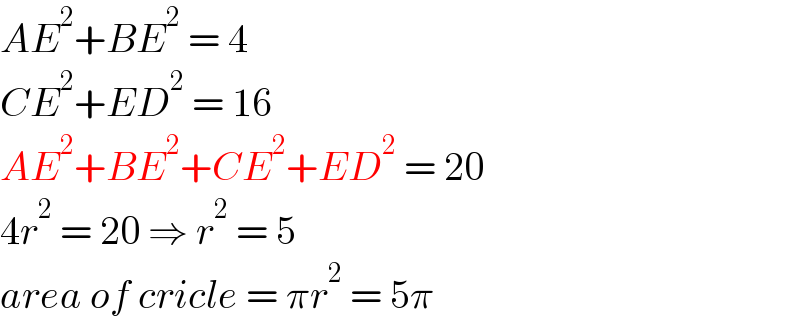
$${AE}^{\mathrm{2}} +{BE}^{\mathrm{2}} \:=\:\mathrm{4} \\ $$$${CE}^{\mathrm{2}} +{ED}^{\mathrm{2}} \:=\:\mathrm{16} \\ $$$${AE}^{\mathrm{2}} +{BE}^{\mathrm{2}} +{CE}^{\mathrm{2}} +{ED}^{\mathrm{2}} \:=\:\mathrm{20} \\ $$$$\mathrm{4}{r}^{\mathrm{2}} \:=\:\mathrm{20}\:\Rightarrow\:{r}^{\mathrm{2}} \:=\:\mathrm{5} \\ $$$${area}\:{of}\:{cricle}\:=\:\pi{r}^{\mathrm{2}} \:=\:\mathrm{5}\pi \\ $$
Commented by mr W last updated on 25/Nov/22
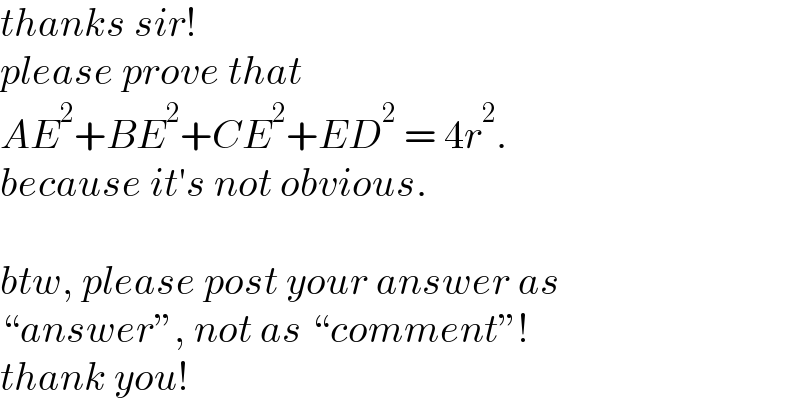
$${thanks}\:{sir}! \\ $$$${please}\:{prove}\:{that} \\ $$$${AE}^{\mathrm{2}} +{BE}^{\mathrm{2}} +{CE}^{\mathrm{2}} +{ED}^{\mathrm{2}} \:=\:\mathrm{4}{r}^{\mathrm{2}} . \\ $$$${because}\:{it}'{s}\:{not}\:{obvious}. \\ $$$$ \\ $$$${btw},\:{please}\:{post}\:{your}\:{answer}\:{as} \\ $$$$“{answer}'',\:{not}\:{as}\:“{comment}''! \\ $$$${thank}\:{you}! \\ $$
Commented by universe last updated on 25/Nov/22
https://youtu.be/1EkoaQJyrfk
Answered by HeferH last updated on 25/Nov/22
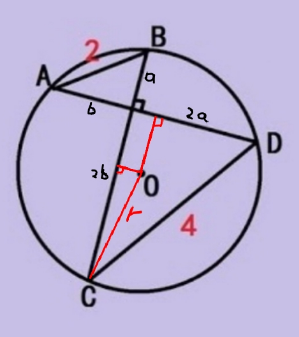
Commented by HeferH last updated on 25/Nov/22
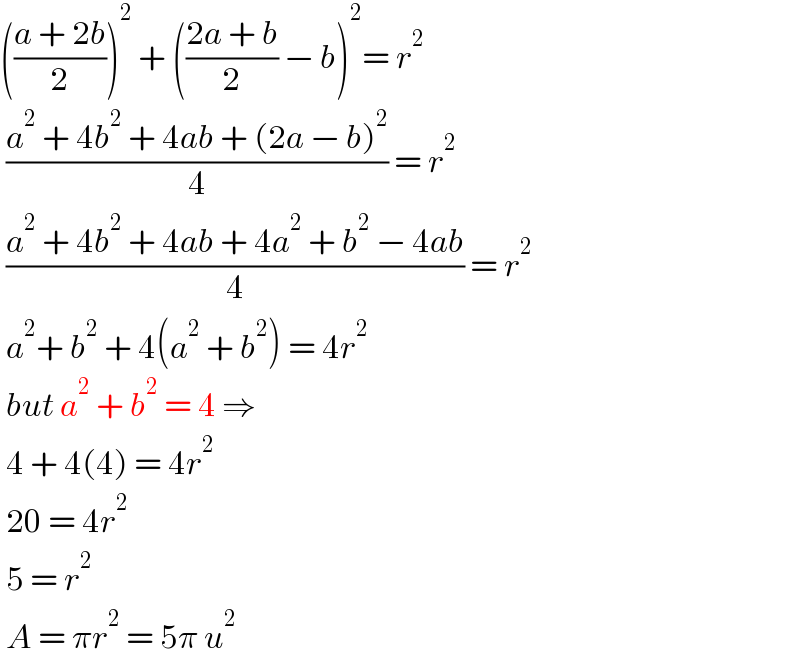
$$\left(\frac{{a}\:+\:\mathrm{2}{b}}{\mathrm{2}}\right)^{\mathrm{2}} \:+\:\left(\frac{\mathrm{2}{a}\:+\:{b}}{\mathrm{2}}\:−\:{b}\right)^{\mathrm{2}} =\:{r}^{\mathrm{2}} \\ $$$$\:\frac{{a}^{\mathrm{2}} \:+\:\mathrm{4}{b}^{\mathrm{2}} \:+\:\mathrm{4}{ab}\:+\:\left(\mathrm{2}{a}\:−\:{b}\right)^{\mathrm{2}} }{\mathrm{4}}\:=\:{r}^{\mathrm{2}} \:\: \\ $$$$\:\frac{{a}^{\mathrm{2}} \:+\:\mathrm{4}{b}^{\mathrm{2}} \:+\:\mathrm{4}{ab}\:+\:\mathrm{4}{a}^{\mathrm{2}} \:+\:{b}^{\mathrm{2}} \:−\:\mathrm{4}{ab}}{\mathrm{4}}\:=\:{r}^{\mathrm{2}} \\ $$$$\:{a}^{\mathrm{2}} +\:{b}^{\mathrm{2}} \:+\:\mathrm{4}\left({a}^{\mathrm{2}} \:+\:{b}^{\mathrm{2}} \right)\:=\:\mathrm{4}{r}^{\mathrm{2}} \\ $$$$\:{but}\:{a}^{\mathrm{2}} \:+\:{b}^{\mathrm{2}} \:=\:\mathrm{4}\:\Rightarrow \\ $$$$\:\mathrm{4}\:+\:\mathrm{4}\left(\mathrm{4}\right)\:=\:\mathrm{4}{r}^{\mathrm{2}} \\ $$$$\:\mathrm{20}\:=\:\mathrm{4}{r}^{\mathrm{2}} \\ $$$$\:\mathrm{5}\:=\:{r}^{\mathrm{2}} \\ $$$$\:{A}\:=\:\pi{r}^{\mathrm{2}} \:=\:\mathrm{5}\pi\:{u}^{\mathrm{2}} \\ $$
